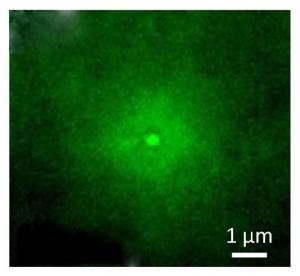Dynamics of hot electrons and applications
P.I.: Bruno Palpant
Exciting plasmonic nanoparticles by subpicosecond laser pulses may results in the formation of a hot electron distribution in the NPs. We define a hot electron gas through an electron temperature (real or effective, in the case of a non-equilibrium regime) reaching a much higher value than the metal ionic lattice temperature.
Along the dynamics of excitation and relaxation of these hot electrons a lot of interesting phenomena are generated, that are absent in the usual continuous irradiation case and can be further exploited in photonic, chemical or biomedical applications: photoluminescence, electron photoemission, enhanced interface electron transfer, production of free radicals in water, cavitation, nanobubble formation.
Selected achievements
Effective photo-generation of a nano-plasma and reactive oxygen species from single gold NPs
In partnership with the team of R. Pansu (CNRS & ENS Paris-Saclay), we demonstrated the ejection of electrons by individual gold nanorods under pulsed laser irradiation, which induces the production of a nano-plasma in water and, further, of reactive oxygen species (ROS) over a spatial range of several micrometers. In addition, NPs emit an ultrafast flash of white light, which can be used for imaging purposes. All these processes have multiphotonic origins through the production of a hot electron gas within the NPs. They can be applied to new localized therapeutic strategies such as photodynamic therapy PDT.
Long-range production of ROS by ultrashort-pulse irradiation of a single gold nanorod imaged by fluorescence probe microscopy. A fluorescent molecule detects the presence of ROS around the single nanorod shined with sub-picosecond laser pulses tuned to its longitudinal plasmon resonance. The bright spot at the NP location corresponds to multiphotonic photoluminescence.
The transient modulation of the nanoparticle optical properties follows the dynamics of the hot electron gas. We have recently demonstrated that this may affect significantly the absorption cross section of the nanoparticles. The resulting effective nonlinearity is complex, as its sign depends on the laser intensity.
Ongoing projects
Plasmonic formation of reactive oxygen species and application to photodynamic therapy
ROS are known as sources of oxidizing stress for cells, which is the basic mechanism of PDT. While the latter is usually carried out in clinical applications – for instance in dermatological, ophthalmological or urological cancers – with porphyrin-type molecules, it has recently been shown that Au NPs alone can generate ROS for destroying cancer cells without any use of such photosensitizing molecules.
However, several challenges are still to be tackled to understand the basic mechanisms and optimize the biomedical application.
We lead a project, supported by the French “Plan Cancer” and the French National Research Agency (ANR) as part of the “Investissements d’Avenir” program (Labex NanoSaclay), which aims at addressing these points thanks to a relevant partnership of physicists, chemists, biologists and oncologists from Paris region.
Gold nanoparticles for PhotoDynamic Theray (PDT)
A video realized by Timothée Labouret, a former PhD student of the team (video in French here)
Partners
L. Douillard, C. Fiorini & F. Charra, SPEC/CEA; S. Marguet, NIMBE/CEA; G. Bousquet & C. Leboeuf, Hôpital Avicenne AP-HP, Université de Paris, Inserm
Related publications
-
Coating gold nanorods with silica prevents the generation of reactive oxygen species under laser light irradiation for safe biomedical applications, Sarra Mitiche, Syrine Gueffrache, Sylvie Marguet, Jean-Frédéric Audibert, Robert Bernard Pansu, and Bruno Palpant, Journal of Materials Chemistry B. 10, 589-597 (2022). DOI: https://doi.org/10.1039/D1TB02207E.
-
Absorption of ultrashort laser pulses by plasmonic nanoparticles: not necessarily what you might think, Xue Hou, Nadia Djellali and Bruno Palpant, ACS Photonics 5 (9), 3856–3863 (2018). DOI: 10.1021/acsphotonics.8b01012
-
Nonthermal model for ultrafast laser-induced plasma generation around a plasmonic nanorod, T. Labouret and B. Palpant, Phys. Rev. B 94, 245426 (2016). DOI: 10.1103/PhysRevB.94.245426.
-
Plasmon-assisted production of reactive oxygen species by single gold nanorods, T. Labouret, J.-F. Audibert, R. Pansu and B. Palpant, Small 11 (35), 4475-4479 (2015). DOI: 10.1002/smll.201500509
-
Influence of laser pulse characteristics on the hot electron contribution to the third-order nonlinear optical response of gold nanoparticles, Y. Guillet, M. Rashidi-Huyeh et B. Palpant, Phys. Rev. B 79, 045410 (2009).


